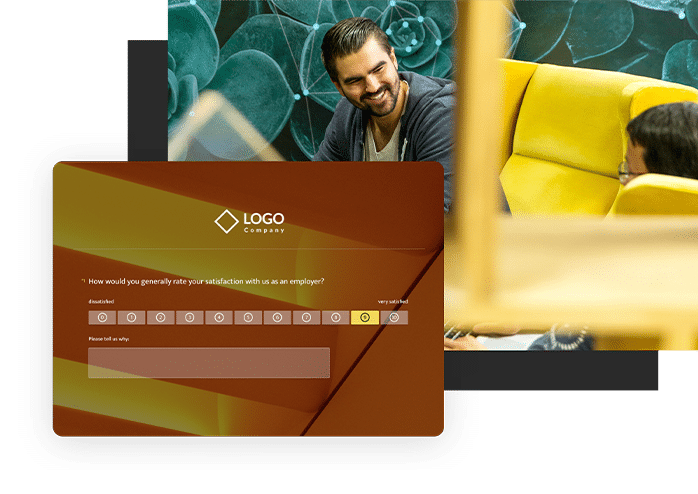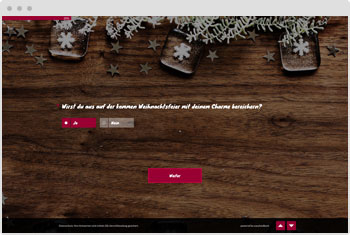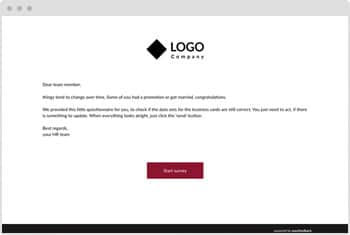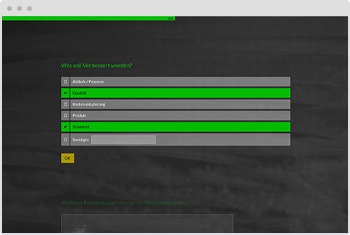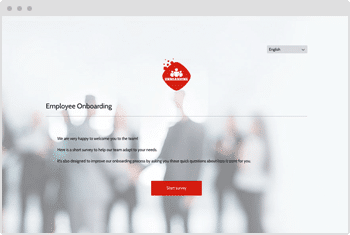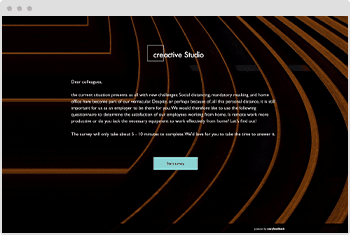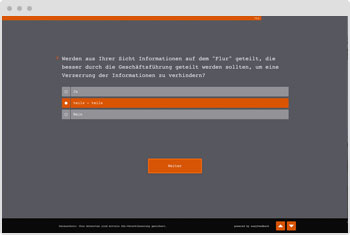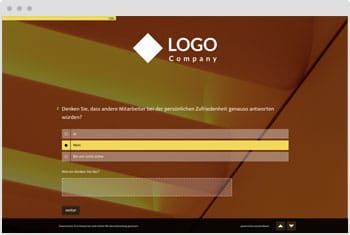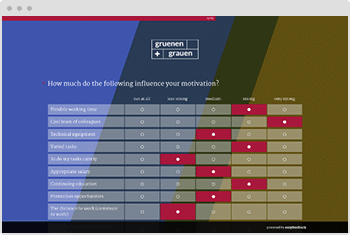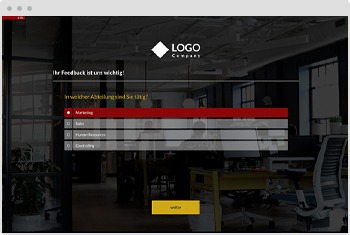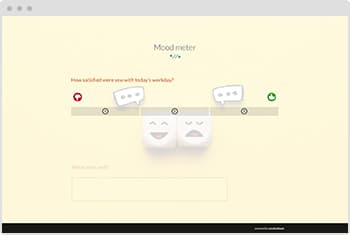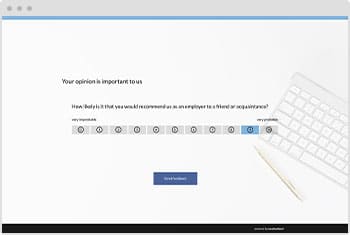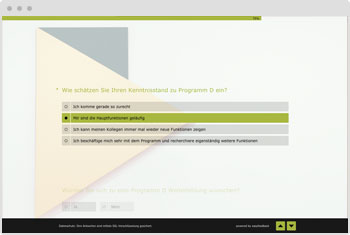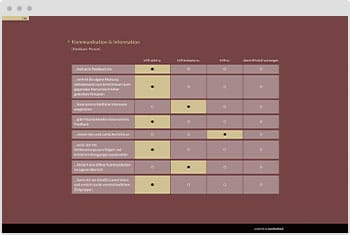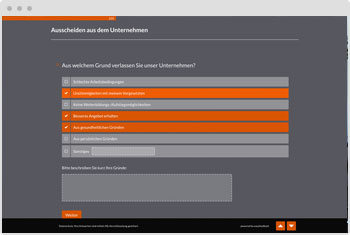Create great employee surveys
Free templates, expert tips & anonymous questionnaires – with easyfeedback you create GDPR compliant employee surveys and protect your employees.


Thousands of companies have already created surveys with easyfeedback. And more companies are joining every day
Why conduct employee surveys?
Open up a dialog with your employees.
Because they are the assets of every company. They do their job every day and are therefore the engine of business success. If the motivation of the employees decreases, their performance usually decreases as well.
Some of the things that can increase motivation are quite simple: Meal offers, equipment at the workplace or the communication with superiors.
Create your individual employee survey with easyfeedback and use the results to create an optimal working environment.

Increase employee satisfaction
Continuous employee surveys give you a picture of employee satisfaction and allow you to act quickly when needed.

Strengthen employer brand
By continuously increasing employee satisfaction, you automatically strengthen your attractiveness as an employer brand and ensure a steady flow of applicants.

Reduce fluctuation
As a further effect, fluctuation in the company decreases with increasing satisfaction and talents remain with you longer.

Improve working atmosphere
Through regular employee surveys, your employees see that something is improving for them personally and are elected to provide answers even to critical issues.

Increase willingness to perform
Increasing satisfaction through employee surveys also inevitably results in stronger employee commitment, which in turn increases performance.

Optimize workflows
Weak points appear everywhere and have a negative impact on economic figures. With employee surveys, you can uncover these and actively optimize them.
Highlights of the easyfeedback survey software
Individual evaluation
Analyze the results of your employee survey according to your own criteria and share them with stakeholders – with a click and in real time. For internal presentation, simply export the results into the desired format.

Anonymity
Put your employees first and protect them when they participate in employee surveys. Because only those who are not afraid to draw personal consequences from their feedback will also answer honestly.

Data protection
As a German provider of employee surveys, easyfeedback consistently relies on data protection in accordance with the Data Protection Regulation (GDPR): server location in Germany (ISO27001), trained employees, data protection officer and other security measures.

Corporate Design
Strengthen the confidence in the survey with your corporate design and show yourself as the sender of the employee survey: Logo, font, colors & images. Each design automatically adapts to the different end devices – desktop, tablet or mobile – without further adjustments.

Start your employee survey with a free template

Organization & feedback
Organization is often a challenge in many companies, groups and public services – regardless of the number of employees and size. Many opinions and wishes have to be taken into account. With an employee questionnaire for planning events, such as Christmas parties or board meetings, you receive structured feedback and have an organizational advantage. Employee surveys can also be used in other ways and give you an organizational advantage – e.g. for updating business card data or for suggestions for improvement via the suggestion scheme.
Employee onboarding feedback
The first experience potential employees have with your company is before they are hired. Usually, the first point of contact is the job advertisement or application form that your applicants use to get in touch with you. After the employment relationship begins, employee onboarding also starts, integrating the new employee into your internal work processes, structures and team. Create a first-class employee experience from the first applicant contact and increase the quality of your onboarding processes by using the feedback from your employee survey.
Optimization & communication
Improvements and optimizations are a central factor in every company. Using online surveys, you offer your employees an easy way to submit suggestions for improvement at any time – anonymously or personalized. With continuous feedback from a pulse check, on internal communication or workplace stress, you optimize work processes and strengthen the corporate culture. Use the free questionnaires as samples and give your employees a voice.
Strengthening the employer brand
The attractiveness of the employer brand – one of the most important cornerstones in the field of human resources. It is the image of your company, which is carried outward to potential applicants. How good are the workplace conditions? How much mental and physical strain do the employees have to endure? Simply put: How satisfied are your employees? With regular employee surveys and follow ups, you maintain and strengthen employee satisfaction, retain talent, and encourage applicant flow. Start your first employee survey with free templates.
Training & development measures
Continuously employing a high proportion of professional staff means positioning the company competently. This requires regular internal or external training or continuing education for individual employees in the respective areas of the company.
According to the study, more than half of the employees are of the opinion that further training is absolutely necessary in their professional life. A survey is used to precisely determine this need, which is then followed by planning through the evaluation of the results. The review of successfully implemented measures can also be carried out conveniently via online survey.
360 degree feedback
Managers are key people in any company. They pass on the values of the company to the employees, develop them and are responsible for achieving goals. With 360-degree feedback, you give managers the opportunity not only to assess themselves, but also to be assessed from different perspectives. This gives them an honest outside perspective on their strengths and weaknesses. From the feedback, bosses and managers can improve their professional and personal competencies.
Exit interview
With an exit interview, you learn the reasons behind the employee’s termination. Is it personal reasons? Do the workplace conditions or corporate culture no longer fit? Take action based on the feedback received to reduce the fluctuation rate and improve organizational processes. This will also benefit the company’s reputation and thus the attractiveness of the employer brand in the long term. The exit interview can be conducted anonymously or personalized so that no participant has to feel uncomfortable within the survey.

Choose the right plan for your employee survey
The easyfeedback plans are ideal for small and large companies. A one-time employee survey can already be carried out in the Starter or Single plan.
For those who want to compare the results across departments and need the anonymity function, the Business plan is ideal. And for companies that want to work with several departments, the Company plan additionally offers working in autonomous teams, with which sensitive data can be protected.

Tip: Involve the works council cleverly
The works council is a key person in the company and should be cleverly involved in every employee survey. Thus, you will receive the necessary support for your project right from the start. Read more about how to involve the works council in your employee surveys.
Related articles about Employee Experience
Almost everything you need to know about employee surveys
1. What is an employee survey? Definition and purpose
Employee surveys are an internal instrument that is usually used by the human resources department to obtain a partial or overall assessment of the company-related framework conditions and to allow improvements to be made on the basis of these.
2. Why conduct employee surveys?
With employee surveys, entrepreneurs and human resources departments in particular have gained a valuable
Instrument to identify improvement potential in the areas of satisfaction, personnel development, health promotion, optimization of work processes and much more.
Optimize internal company communication, improve the working atmosphere or establish a company innovation and idea management system with regular employee surveys.
Find out about the current motivation, commitment or satisfaction and the mental and physical stress of your employees with regular employee surveys.
Find out how you can strengthen the attractiveness of your employer brand in order to retain your employees in the long term, reduce fluctuation and attract new talent.
Have managers assess and promote them and employees with a 360-degree survey with regard to missing personal and professional skills through further education and training.
Open the dialogue with your employees with surveys from easyfeedback and become a top employer with their help.
3. How often should one conduct employee surveys?
The frequency of the survey depends on the purpose and objectives of an employee survey and the resources available to you.
If, for example, you would like to give your employees the opportunity to further their professional development through training and workshops, you can use a survey to identify the need for further training and the interest in further training. In this way, you can create and promote the training offer in a targeted manner afterwards.
Most people would consider the survey project to have been successfully completed after the survey has been conducted, analyzed and evaluated. But actually, once you have sent your employees on the training course, you would have to create another survey to measure their satisfaction. Ultimately, it is to your advantage to know whether the offered course could provide added value.
After you have received the feedback from the survey, you will go back to the evaluation and analysis. As you can see, the continuous survey creates a feedback loop that consists of questioning employees, evaluating the survey, deriving measures, implementing measures, receiving feedback from employees again, evaluating feedback and so on.
In summary, it can be said that the intensity and frequency of employee surveys always depends on the goal and purpose, but also on the size of the company and the resources available.
4. On which topics is an employee survey useful?
There are many different topics that are suitable for an employee survey. We have compiled four potentially important topics for you below:
Employee satisfaction
This type of survey collects information about employee satisfaction. The goal is to use the results to identify areas or topics where adjustments can help optimize the employee work environment. Relevant questions here could focus on satisfaction in terms of work-life balance, the working atmosphere or workload.
Organizational culture
An employee survey on organizational culture is useful when structural changes are made in the company. In practice, this involves, for example, the merger of two companies or the merging or separation of departments or teams. The survey can be used to find out about employee acceptance on the one hand and possible improvements in cooperation or potential problems and challenges on the other.
Business processes
By surveying your employees about business processes, you can find out first-hand how work processes really work, where things may be getting stuck or where there is still room for improvement. Here, for example, a short survey on work equipment or surveys that revolve around organizational topics are suitable.
Leadership behavior
A survey on the leadership behavior of superiors can also be an area with great potential. A 360-degree feedback survey is a good choice here. In addition to the employees, other sources such as the managers themselves, customers or the management are included here. The results provide information about self-perception and external perception, among other things.
5. What should the process of an employee survey be like?
In the following, we have outlined a five-step process that you can use as a guide for your next employee survey:
1. Preparation
Before you start with the concrete planning and implementation of the survey, you should define the goal and purpose of your survey. What do you want to achieve with the employee survey? On which topics and, above all, how do you want to survey your employees (paper-based or digital)?
Then you can start developing the questionnaire. In addition to selecting suitable questions, this also includes designing the questionnaire and coordinating with the responsible departments, such as the department heads, the data protection officer and the works council. If you are using an online questionnaire, your agenda should also include selecting a suitable software tool for creating and conducting the survey.
You should also communicate the survey to your employees in advance. Talk openly and honestly about the purpose of the survey and that it will be conducted anonymously, if intended. In this way, you eliminate any possible skepticism on the part of your employees in advance and motivate them to participate.
2. Conducting the survey
Have you prepared everything? Then you can start collecting data. In this step, you share or send out the employee survey and keep an eye on the response rate. If necessary, remind your employees to participate in the survey.
3. Evaluation
The participation period is over and you were able to get enough employees to participate in your survey? If so, that’s the end of the survey and it’s time to start evaluating the responses.
However, before you start evaluating the responses from the (online) survey, you should first take a look at how high the participation rate was and how many of your participants dropped out of the survey. This will tell you whether your survey was well received, whether there were problems with certain questions that led to them dropping out or not answering questions, or whether the questionnaire was possibly too long.
Afterwards, it is time to evaluate the feedback. Interpret the results using charts and tables and try to read between the lines when answering open-ended questions. What do your employees want you to know?
Furthermore, forming comparison groups, such as comparing two departments or different age groups, can be helpful in highlighting possible differences between the selected groups.
Finally, record the results and the action measures derived from them in an appropriate report or presentation. Do not forget to communicate these to your participants as well and to involve your workforce in the further process.
4. Implementation
Your survey has been evaluated, the results are on your desk in black and white. Now it’s time to implement the measures derived from the evaluation.
Did your employees express wishes or specific problems in the survey? Then incorporate them into your measures to increase employee satisfaction.
5. Repetition
After the survey is before the survey. Regularly check whether the implemented measures are having the desired effect by conducting further and more in-depth surveys.
6. How do I create the ideal employee questionnaire?
We are often asked about the ideal questionnaire for an employee survey, and we have to tell you that this does not exist.
Every company and every situation is so individual that there is no standard questionnaire for every company and every situation. Nevertheless, there are certain basic rules which are identical for all employee surveys:
Questionnaire length: In general, we want to obtain as much information as possible. And one more question and one more small question and … one question still fits.
Good for the management and personnel department, but not pleasant for the employee. And this is exactly where you have to start: What is the purpose of the survey? How often is this survey conducted? And do you have to query all these details, or can you store them as master data?
The higher the bond to the author of the survey, the more I can demand from the participant. Employee surveys perse have a high level of loyalty – employer – and surveys “can” be designed longer and more complex.
However, if you carry out a long and complex survey every month, then by the third month at the latest, the participation rate will drop to such an extent that you will actually no longer be able to carry out the survey.
Therefore, pay attention to the frequency in combination with the questionnaire length. With a high frequency you keep the questionnaire short; with a low frequency the survey can be longer.
Always put yourself in the position of the employee, then you will quickly notice whether the respective length – response time – is too long or not.
7. Can I use existing knowledge when creating the employee survey?
Employee surveys can be roughly divided into 3-4 areas:
- Annual “great” satisfaction and mood surveys
- Short fast feedbacks –
- Pulse check
- Organizational surveys
- Evaluation surveys of colleagues and managers
Certainly the topics can be further subdivided. However, this list already shows that an employee survey on organizational topics or a pulse check is much easier to implement than a full survey of the entire workforce commissioned by the management.
You will certainly often find yourself in the situation that you are working on certain topics for the first time. Before you start from scratch, it is worthwhile to fall back on existing knowledge. On the one hand, you look internally at previous employee surveys and inquire about their success, and on the other hand, easyfeedback provides you with various templates on the subject of employee surveys, which you can adapt individually to your needs.
Even if questionnaires already exist, but they do not directly address your topic, they still provide a basis for inspiration – both in the formulation and the structure of the questions.
8. How do I formulate a cover letter/invitation to the employee survey?
Your invitation plays a significant role in whether the recipient takes part in the survey. Formulate your invitation charmingly and in such a way that it arouses the interest of your employees. Address your employees personally and feel free to use the customs that exist in your company.
Create a “we” feeling already in the invitation by pointing out common goals. Of course, you should also include basic information about the survey process in your invitation. The following information should not be missing:
First, state the topic of the survey and the goal of the survey. This way, your employees will know right away what the survey is about and will certainly be happy to help you. Don’t forget organizational (start and end of the survey) and technical information, such as how often participation is possible and whether it is possible to re-enter online surveys.
So that your staff can integrate the survey well into their daily work, you should also indicate approximately how long the survey will take. Do problems or queries arise? In this case, you should name a contact person with the relevant contact data such as telephone number and e-mail address in the invitation.
It is very important that you state in your cover letter whether participation in the survey will be anonymous or personalized. This information is important and also plays a significant role in whether the recipient of the invitation takes part in the survey or not. Especially in the case of a personalized survey, the participant must be informed of his or her rights and the scope and purpose of the survey via the data protection notice. Also tell him what personal data you are asking for, for example, e-mail address or name.
Finally, all that’s missing is the survey link and you’re ready to start the survey.
9. Should the works council be involved in the employee survey?
Depending on the type of employee survey, the works council may want or need to be involved. In the case of short organizational questions on the next topics in a meeting, the works council will probably have little interest in coordinating the questionnaire, but in the case of larger employee surveys it will be interested. And even if he only wants to be informed about the project.
In general, it is advisable to involve the works council. The works council is the main responsibility of the employees. And that is why it is always advisable to involve the works council. Under certain circumstances, the works council can even speed up the process for your project with the management.
However, already when planning your employee survey, consider whether you need to involve the works council or not. If you want or have to involve the works council, you should include it in your timing. Otherwise your survey project could be delayed.
10. Should employee surveys be conducted anonymously or personalized?
An anonymous employee survey is one of the basic prerequisites for obtaining honest feedback on sensitive issues. Because only if the employee does not have to be afraid to draw personal consequences from his answers will he answer you honestly. If you do not ensure anonymity for critical issues, mistrust will increase and you will not receive the answers you need to make improvements.
However, the questions, whether anonymous or not, are not so easy to answer. Because even if the survey is to be anonymous, you need certain information to assign the answers. For example, the location or the department is an important additional piece of information in order to implement specific measures afterwards. Or in the case of 360-degree feedback, you need to know for whom the feedback is being given.
In all critical and sensitive employee surveys, anonymity should protect the employee from being identified.
As soon as you can only draw a conclusion on a mass of employees, e.g. a department with 15 people, the protection of each individual is guaranteed and you will also receive the necessary information to assign the answers to an area. If a department is too small, then combine it with another department to maintain the protection of the individual.
easyfeedback offers you special anonymity functions and mechanisms to protect each individual employee and at the same time provide you with enough information to evaluate the results in a valuable way.
11. How to evaluate & analyze the employee questionnaire correctly?
The evaluation and analysis is the most exciting part of the employee survey: What results have we achieved? What is the mood in the workforce?
After you have prepared everything and the first employees have participated, the evaluation and analysis takes place. During the ongoing survey you will certainly observe the development on a daily basis. During this period you can already discover initial trends and develop a feeling for the final result. However, you should not draw too hasty conclusions here, as the employee survey is not yet complete and the results may still change.
As soon as the period for the employee survey is over, it is also advisable to stop the survey. This ensures that no further results are included in the evaluation and that your analyses are not changed.
If you now begin to evaluate and analyze the quantitative and qualitative answers, you should put yourself in the employees’ perspective. This gives you a better understanding of the answers. Because working conditions in the office are different from those in production. At the desk there is usually silence and in production noise or heat influence the perception. It is also a difference whether an employee is on a monotonous assembly line or under time pressure because he has one meeting after another in his diary.
Therefore always consider the circumstances in which the individual employee or department is located.
External circumstances can also influence the answers. If short-time work has just been announced in a works meeting, the mood of the individual employees is depressed and will probably also affect the answers.
Their first glance will probably fall on the overall result. This is usually the first thing you see, or would like to get an overview. However, this is not very meaningful, since the answers from the different departments and work areas are cumulated.
View the results separately for each area and department. This is the only way to see where there are deficits in the individual areas or where the mood is changing.
If you have asked for data on the gender of employees, length of service and age range, you can use it to perform a deeper analysis:
How does the satisfaction of young employees change in relation to older employees? Or are there differences in satisfaction among employees who have only been with the company for a short time or who have been working with you for many years? Or are there differences between the sexes? Are women generally more satisfied or rather sceptical?
With these three details, you can gain valuable insights and derive targeted measures. For example, you will find that older employees who have only been with the company for a short time are often dissatisfied. This can be an indication that the onboarding is not carried out sufficiently. Presumably, the assumption is that older people have a large pool of experience available and that onboarding can be kept shorter. However, if they are not sufficiently introduced to the goals and values of the company, they may not understand certain decisions.
Another tip is to consider the sample size. Every single opinion is and should be taken seriously, but it does not form a whole. Do not be irritated by isolated opinions. In order to make valid statements, at least 15-20 feedbacks should be used to identify tendencies.
12. Any tips for conducting employee surveys?
We have compiled four tips below to help you conduct your next employee survey.
Tip 1: Define clear objectives
Avoid a disjointed survey where you collect a lot of responses but ultimately do little with them. Therefore, think about exactly what your goal is in advance.
Is it about improving employee satisfaction, strengthening the employer brand or should work processes be adapted? Limit yourself as much as possible to one area, ask your questions in a structured way and focus on your defined intention.
Tip 2: Anonymous and voluntary
Employee surveys are a sensitive topic: You can only expect open and honest answers if no conclusions can be drawn about the person answering the question and your employees trust the anonymity. Otherwise, there is a risk that the desired feedback will be glossed over or that participation will be refused altogether.
In the event of a refusal, it is important not to put pressure on employees and always offer participation on a voluntary basis.
Tip 3: Ask open-ended questions
If you only ask yes/no questions, you will also only get a one-syllable answer. Let’s assume the following question in your survey: “Do you see opportunities for improvement in area XY?” Your employee properly answers this question with a, “Yes.” Everything is correct as far as it goes, but the information is of little help to you because you cannot deduce from the answer what exactly the need for improvement is.
In contrast, if you ask the open-ended question: “What need for improvement do you see in area XY?”, you will receive a more targeted answer with important information that you can directly address.
Tip 4: Inform your employees
An important aspect is to involve your employees at every stage of the survey. Communication should start before the survey by telling your employees why you are conducting it.
But you should also keep your employees informed during and after the survey. For example, let them know how many colleagues have already taken part in the survey and motivate those who have not yet done so. Or provide information on an alternative way to participate in the survey, for example via QR code with a smartphone or via survey terminals.
It is also a good idea to present the results to your employees after the survey has been completed and inform them what further steps you are planning.
These were our tips, which we would like to share with you for conducting an employee survey. If you need more suggestions or assistance on how to conduct employee surveys, feel free to check out our blog article on the topic.
13. What are typical mistakes in conducting employee surveys?
The success of an employee survey depends on several factors. Each individual factor can be decisive for the success of the survey. You should therefore pay attention to typical mistakes:
Feigning anonymity
As mentioned above, anonymity is an important part of sensitive employee surveys. However, it is not always desired or not wanted in order to be able to better evaluate the results. Do not make the mistake of pretending anonymity. You won’t believe how creative your employees can become.
If you fake anonymity, some employee will notice – consciously or unconsciously – that anonymity is not given. And once the circumstance is revealed, your credibility is no longer steady and all preparations for the employee survey are invalid.
Not sufficiently informed about the reason for the employee survey
Many employees are initially sceptical about a survey. Especially in the early stages, when you introduce a new system. However, not directly towards the system, but much more towards the reason for the employee survey. While you and your managers or the management have made the decision to optimize internal processes and improve the working atmosphere, your employees have not noticed anything.
For you the goal is clearly defined and has been known for weeks, your employees probably don’t know about it yet. Therefore, inform your employees sufficiently about the reason for the surveys. Where is the goal? What are the personal advantages for the employees from participating? How often and on which topics are employee surveys conducted?
The more you involve your employees in the project, the more successful the surveys will be.
Wrong time
You worked for weeks towards your first employee survey. From internal objectives to the questionnaire and the pre-test. Everything is in place and has been tested – and then you overlook one little thing: the timing.
Even with the best prepared employee survey you will not achieve the maximum if you carry it out during the peak of the holiday season. When choosing the time, pay attention to external influences, such as vacation time, imminent final phases of a project where a lot of overtime is worked, or an increased sick leave due to e.g. a wave of flu.
Do not communicate at eye level
Everyone wants to be treated with respect. Nobody likes to be bossed around. This is how you should handle it in the employee survey. Communicate with your colleagues at eye level. Put yourself in their shoes and ask questions and answers at eye level and from their perspective. If the employees have the feeling that the employee survey is only being conducted for the management, they will convey this in their answers.
No personal advantages for the employee
Participation in the employee survey is a gift of attention from the employee. There are various reasons for general participation in surveys. But almost all of them have one thing in common: everyone who takes part in a survey expects something in return. If the employee cannot derive any personal benefit from his or her participation, he or she will take part for the first time and perhaps also for the second time. After that, however, the participation rate will drop sharply. Because why should he also participate if he has nothing from it.
Simple example: If you ask your production employees about the work tools available and where there is room for improvement, then the employee will see that his participation will improve something. And at the end of the day he will gain a personal advantage.
Do not let actions follow
As described in the previous points, you have implemented all tips and carried out a good employee survey. In the end, you analyzed the results and derived further measures. Since you probably have other tasks in your day-to-day business, it can happen that the measures lose priority and take a back seat.
This last point can cost you a lot of trust among your employees. Because they have given you the necessary attention, are motivated and are already looking forward to better tasks and conditions and then no action follows.
By the second employee survey at the latest, resentment will arise and the first opponents will form. Therefore, make sure that you also implement measures from the results. The first measure can be to publish the results in front of the employees and to let them participate. At one point or another, there may be a need for follow-up discussions – also within the team – to plan the measures in more detail.
The next step would be to implement the measures with the least effort and highest impact. Or, if this is too costly, first implement only those measures that can be implemented quickly. Then the employee will see that his or her voice really does make a difference and will also pay attention to you in the following employee surveys.
In addition, the satisfaction of each individual employee will increase continuously and you will have a more efficient team.
14. How can I pay attention to data privacy in employee surveys?
The best way to ensure data protection in employee surveys is to design the survey in such a way that no conclusions can be drawn about the individual employee. In an anonymous survey, no personal data is usually collected and your employee survey therefore does not fall within the scope of the GDPR. Nevertheless, you should make sure that the function cannot be technically bypassed.
If you conduct the survey online in Europe, make sure that the selected software solution complies with GDPR data protection regulations. This includes data encryption, protection against unauthorized access and a server location in Europe.
It is best to involve your works council, the data protection officer and your employees right from the start and create transparency with regard to the purpose, process and who is conducting the survey.
15. Why conduct an employee survey with easyfeedback?
With our survey tool you can easily create anonymous & DSGVO-compliant employee surveys without any previous knowledge.
Determine employee satisfaction and employee motivation, ask for improvement requests, conduct votings and polls online or measure the current workload of your employees.
With easyfeedback, you can set up surveys flexibly according to your wishes. With different question types, dynamic content and different media, you can design them individually. We also offer ready-made templates and sample questionnaires for the various employee surveys for immediate use.
All surveys can be customized to your corporate identity with just a few clicks and your participating employees can be invited through various channels (via link, QR code, email invitation tool and more).
You will receive the answers of the participants anonymously and in real time. The results are automatically presented in the form of diagrams and tables. You have the possibility to create filters to get deeper insights into the data.
Create regular employee surveys and collect data using a modern and secure survey engine with easyfeedback.
Some advantages of the survey tool at a glance:
- create anonymous surveys without previous knowledge
- select and adapt finished sample questionnaires & templates
- questionnaire easily adapted to your corporate design
- invite participants to the survey through various channels
- questionnaire retrievable with any terminal device
- real-time evaluation
- GDPR compliant & Server in Germany



